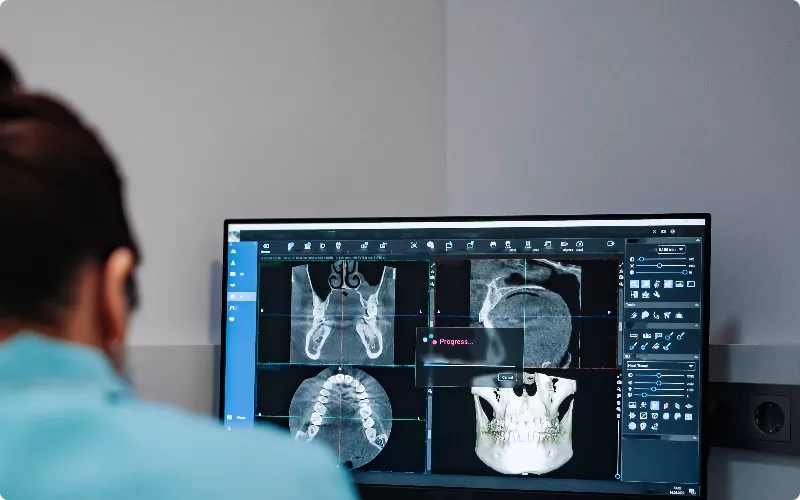If you were to sustain a sudden facial trauma or injury with cuts that require stitches by our oral maxillofacial surgeon, we would evaluate your facial structure.
Should you break a bone, either in your face or in your jaw (something that is fairly common), the assessment would take into account how it will impact your speech, biting, and chewing abilities. Depending on the severity of your facial injury, you might need only one area fixed while in extreme cases, you could require a full mouth reconstruction.
Common Causes of Facial Trauma
- Cancer
- Injuries in the workplace
- Periodontal disease
- Physical abuse
- Sporting injuries
- Vehicle accident
The bones in your face that can suffer trauma include:
- Forehead or frontal bone
- Orbital bones or eye sockets
- Cheekbones
- Jaws (the upper jaw, or maxillary, and the lower jaw, or mandible)
Unlike a break in a bone such as a leg or an arm, where a cast can be made to stabilize the area as the bone heals, our oral maxillofacial surgeon uses methods that involve wiring the jaws along with rigid fixation using screws and small plates. Should you have a fracture to your jawbone, this can cause trouble breathing, chewing, and even speaking properly.
But one of the biggest reasons for having an oral maxillofacial surgeon conduct your treatment (and healing) is that the structures of the face are delicate, holding lots of sensory nerves that could create a loss of sensation in the affected nerve endings. The face is also connected to the central nervous system, where facial damage can affect the spinal cord.
Treating Maxillofacial Injuries
Soft Tissue Injuries
Lacerations to the face (including the lips, tongue, cheeks, or gums) require careful and strategic suturing. It will help ensure the best cosmetic results and protect the facial structures (like the nerves, salivary glands, and salivary ducts). Being seen quickly for soft tissue injuries helps to ensure less scarring and minimizes the odds of infection, especially with all of the harmful oral bacteria typical in the mouth.
Bone Injuries
Bone fractures in the face can receive treatment like those in other areas of your body. It largely depends on the fracture’s location, how bad it is, how old you are and your overall health. Of course, we can’t put a cast on a facial fracture, but other techniques like wiring your jaws, stabilizing with small plates and screws boost your recovery and healing. Our ultimate goal is to restore your appearance and function while leaving a minimal footprint, so making the least amount of incisions, making them small, and locating them in a manner to minimize scarring and even hiding scars are important to us.
Tooth Injuries
Damaged teeth can be treated by bonding teeth together or treated by splinting using wire. A knocked-out tooth can be replanted if it is treated as soon as possible and protected right away by holding it in a container with milk or saltwater. It increases its survival and means you should be seen as quickly as possible by our surgeon. It also means not attempting to remove any residual debris on the tooth because those tiny bits of ligaments that anchor the lost tooth into the jawbone still need to be attached if we are to reattach the tooth. If a tooth is fractured or requires a root canal treatment, it may also mean getting a root canal or seeing a dentist for restoration. Dental implants may be needed if the tooth is not salvageable in time.
At-Home Surgical Aftercare
Initially, you will want to take it easy and rest whenever you need. Rest is a vital part of recovery. Sleep maximizes healing and now is the time to make sure your body gets all the sleep it needs. Because of the injury to the face, you should elevate your head with extra pillows that you normally use. If sleeping in your bed isn’t helping, try sleeping in a recliner.
Stay away from any activities that might potentially reinjure your face and jaw. You might also not be able to drive for a while because of your medications and how you are feeling. We will also work with you to be able to speak and chew properly again.
You’ll want to stick to soft foods like soups, stews, smoothies and other liquids to get proper nourishment without stressing your facial structures. Once you are cleared to use a straw, this can help alleviate harming the area as well. Staying well hydrated, including plenty of water, gives your body what it needs to recover and avoid dehydration.
Stay on top of your pain medications while your facial trauma recovery process is underway. Be sure to take them only as directed. They are potentially addictive, so only take them per your instructions. Antibiotics need to be taken exactly as prescribed, so take them all until they are gone to avoid relapsing with an infection.
You can expect your facial areas to feel sore for a couple of weeks afterward, and any stitches to your mouth, jaw, or face will typically be taken out after a week. Keep in mind that complete healing can take up to several months.
If you sustained a severe facial injury, you might have to consider that your face may not look like it did before the accident. But with the help of our experienced oral maxillofacial surgeon, we can work to help your face look as close as possible to your pre-injury condition.
Surgical Follow-Up
You will need to attend surgical follow-up appointments with our facial trauma surgeon as you navigate your healing and recovery process. Should you have any questions or concerns, we welcome you to contact our office. We are always a phone call away!


